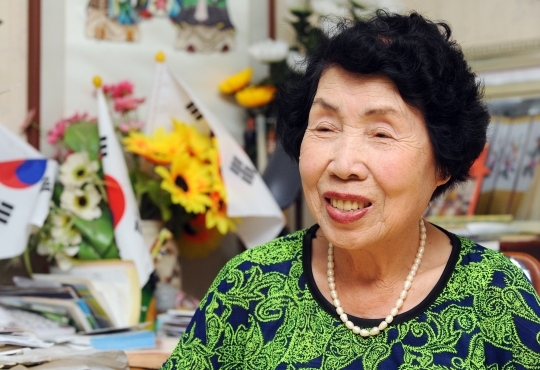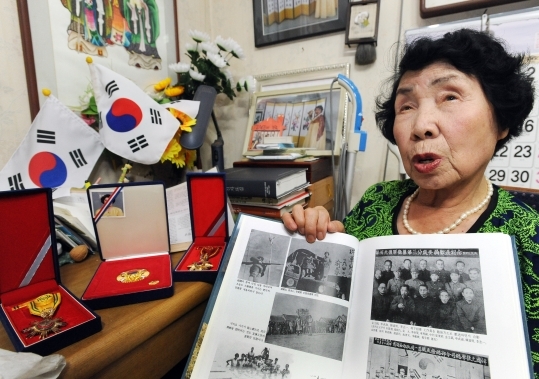“Female Independence Army is the first female army”

To fight against Japan, they recruited soldiers, carried out propaganda activities, and received military training.
As we celebrate the “73rd anniversary” of the Female Army, the age-old tradition of the Female Independence Army has to be inherited
“Female Independence Army is the first female army. The foundation day of the Korean female army, therefore, should be September 17th, 1940 when the Female Independence Army was created. The Army has fought for independence. Their services and sacrifices should be remembered.”
With the 68th anniversary of national independence just around the corner, Women News had an interview with a female veteran, Oh Hee-ok. She was so vigorous that no one could tell she was well over 80 years old. She pulled out her photo album titled “Indomitable national spirit,” and began telling her journey as a female independence soldier. She showed a faded photo of herself with Ji Bok-young, the daughter of General Ji Cheong-Cheon, Oh Gwang-sim, a prominent female independence soldier in China, and her colleague Cho soon-ok.
“Three of them were deployed on the front lines. They recruited soldiers and received proper military training. If the Korean Independence Army successfully carried out infiltration operations, all of us would have fought a battle as well. We were women of bravery and unyielding spirit. At first, I was part of the Korean Youth Independence Corps and then I was assigned to the Female Independence Army. I carried out propaganda activities and performed plays portraying our fight against Japan.”
Her family has devoted their lives to national independence: Her grandfather Oh In-su was the leader of the Yong-in Righteous Army. Her father, General Oh Gwang-seon sought asylum in Manchuria to lead independence movements. Her mother, Jeong Jeong-seon, also known as ‘the mother of Manchuria,’ organized the Korean Women’s Union for Revolution. Her sister Oh Hee-young and brother-in-law Shin Song-sik fought for independence as well. She had another sister who joined the 3rd Unit of the Female Independence Army. Just by taking a glance at photos, one could easily tell that serving as a soldier in a vast land of China was very tough for teenagers. Oh Hee-ok was born in Jilin Province, Manchuria. After Korea gained independence, she returned to her home in Korea and taught students at Wonsam Elementary School in Yong-in.

She showed her regret that not many people these days know about the Female Independence Army. “As we promote gender equality, I just hope that more emphasis would be put on the role of the Female Independence Army. Including it in our textbook could be the first step. From time to time, I argue with bus drivers. Whenever I get on the bus and show my Veteran Welfare Card, they would look at me suspiciously and grumble that they have never met or heard about female independence activists.”
Park Yong-ok, former professor at Seongshin Women’s University and currently honorary president at March 1st Independence Movement Party said, “The Korean Youth Independence Corps was created in China. This laid a foundation for the Korean Independence Army. Among 34 founding members, 11 were women.” She added, “Female members drafted soldiers. With 20 years of combat experience, Oh Gwang-sim contributed more than an ordinary male soldier did. Female members mostly played significant roles in the Army.” “The role of the Female Independence Army in our fight against Japan needs to receive more attention,” she emphasized.
Yoon Jeong-ran, a historian and a researcher at Sogang University commented, “I hope that we would assign a space in the National Women’s History Museum so that more people can learn about women’s role in the independence movement.”
At the end of June in 1945, there were 30 female soldiers in each of 3 Units. Many of them were single and born after 1919.
They came from vastly different backgrounds: Some were from a family of independence activists. Others joined the Army after getting married to an activist. Also, there were some female activists who fled abroad to avoid being caught. Even Gisaeng or Korean geisha participated in the liberation movement. They were different from their counterparts at home who were highly educated.
Female soldiers were paid for their services: They participated in Korea-U.S. joint military drills, carried out undercover activities, and planned for infiltration operations. Although Oh Gwang-sim and Ji Bok-young were female executives, they had to fit themselves into gender roles. They were burdened with chores like sewing, doing laundry, and providing relief supplies.
Researcher Yoon pointed out that “Ji Bok-young decided to join the Army because the interim government was determined to rewrite a constitution, seeking to eliminate discrimination based on social positions and achieve gender equality. Nevertheless, the roles and responsibilities of soldiers were defined by their gender.”

